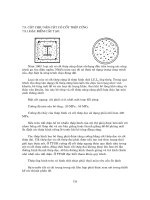White t the animators sketchbook 2016
Bạn đang xem bản rút gọn của tài liệu. Xem và tải ngay bản đầy đủ của tài liệu tại đây (8.97 MB, 328 trang )
Key Features
• Provides readers with their own personal sketchbook, demonstrating
classical art skills that are highly prized by studio employers
• Readers will come away better visualizing form, gesture, pose and
expression. Includes 66 speed and gesture drawing exercises
• Provides the perfect way for students of animation to improve
their core skills
• Perfect for animation instructors who can rely on this unique
course workbook to take their students to new levels of classic
visualizing expertise
About the Author:
Tony White is a British Academy Award–winning
animation director, animator, author and educator. At the beginning of his career, he studied
advanced animation techniques with some of the
finest masters of the art-form. Specifically: Ken
Harris (original lead animator of "Bugs Bunny,"
"Roadrunner," etc.), Art Babbitt (original lead
animator on Pinocchio, Fantasia, etc.) and Richard Williams (3-time Oscar winner and author of
The Animator's Survival Kit). Tony is currently
Senior Instructor for the AIE-Seattle/Seattle
Schools District 'Skills Center' program and
creator of online 2D animation content for AIE in
Australia. Tony is passionately committed to
seeing a return of innovative, top-draw traditional
2D animated filmmaking in the US. To help
realize this dream, Tony has launched the annual
DRAWTASTIC Festival of Drawing and Animation in Seattle, and has started work on his unique
and personal movie project, CULPEPER. Tony's
best-selling animation books include: The Animator's Workbook; Animation from Pencils to
Pixels—Classical Techniques for Digital Animators; How to Make Animated Films, Jumping
through Hoops: The Animation Job Coach and
The Animator's Notebook.
K29590
ISBN-13: 978-1-4987-7401-7
90000
9 781498 774017
THE ANIMATOR’S SKETCHBOOK
The Animator’s Sketchbook will teach students of animation how to
improve their work through observation and drawing. It will show readers
how to access their inner “animator.” With over 60 different gesture and
drawing exercises, this book enhances vision, analysis, understanding, and
the core skills required to become a master animator. Filled with extensive
practice pages, Tony White’s Sketchbook invites students to demonstrate
what they learn. Each exercise is timed, so that the skills acquired are
optimized for efficiency and comprehension. The style and technique of the
art produced will be entirely up to the reader, thus making no two sketchbooks alike.
WHITE
Games &&
Animation
Games
Animation
The
ANIMATOR’S SKETCHBOOK
by TONY
WHITE
How to See, Interpret & Draw Like a Master Animator
The
ANIMATOR’S SKETCHBOOK
How to See, Interpret & Draw Like a Master Animator
The
ANIMATOR’S SKETCHBOOK
by TONY
WHITE
How to See, Interpret & Draw Like a Master Animator
Boca Raton London New York
CRC Press is an imprint of the
Taylor & Francis Group, an informa business
CRC Press
Taylor & Francis Group
6000 Broken Sound Parkway NW, Suite 300
Boca Raton, FL 33487-2742
© 2017 by Taylor & Francis Group, LLC
CRC Press is an imprint of Taylor & Francis Group, an Informa business
No claim to original U.S. Government works
Printed on acid-free paper
Version Date: 20160621
International Standard Book Number-13: 978-1-4987-7401-7 (Paperback)
This book contains information obtained from authentic and highly regarded sources. Reasonable efforts have been made to publish reliable data and information, but the author and publisher cannot assume responsibility for the validity of all materials or the consequences of their use. The authors and publishers have attempted to trace the copyright holders of all material reproduced in this publication and apologize to copyright
holders if permission to publish in this form has not been obtained. If any copyright material has not been acknowledged please write and let us know so we may rectify in any future reprint.
Except as permitted under U.S. Copyright Law, no part of this book may be reprinted, reproduced, transmitted, or utilized in any form by any electronic, mechanical, or other means, now known or hereafter invented,
including photocopying, microfilming, and recording, or in any information storage or retrieval system, without written permission from the publishers.
For permission to photocopy or use material electronically from this work, please access www.copyright.com ( or contact the Copyright Clearance Center, Inc. (CCC), 222 Rosewood Drive,
Danvers, MA 01923, 978-750-8400. CCC is a not-for-profit organization that provides licenses and registration for a variety of users. For organizations that have been granted a photocopy license by the CCC, a separate
system of payment has been arranged.
Trademark Notice: Product or corporate names may be trademarks or registered trademarks, and are used only for identification and explanation without intent to infringe.
Library of Congress Cataloging‑in‑Publication Data
Names: White, Tony, 1947- author.
Title: The animator’s sketchbook : how to see, interpret & draw like a master
animator / Tony White.
Description: Boca Raton : CRC Press, 2016. | Includes bibliographical
references and index.
Identifiers: LCCN 2016016652 | ISBN 9781498774017
Subjects: LCSH: Drawing--Technique. | Animation (Cinematography)
Classification: LCC NC1765 .W475 2016 | DDC 741.5/8--dc23
LC record available at />Visit the Taylor & Francis Web site at
and the CRC Press Web site at
This sketchbook belongs to:
Name _________________________________________________________________________________________________
Contact ________________________________________________________________________________________________
(Please return to the above owner in case of loss.)
I dedicate this book to all those master animators of the future
who are starting their journey on the long road to animation
mastery. Whether you ultimately turn your knowledge to
two-dimensional (2D), three-dimensional (3D), stop-motion,
or any other form of animation, you will find that the work
you put in here will prove the finest foundation you will ever
have to grow and learn! Software and generic techniques can
be learned by anyone. But the work you create through the
Animator’s Sketchbook will be unique to you and you alone.
It is, in fact, that special uniqueness that most employers are
looking for in this day and age, so don’t sell yourself short
with the work you do here. A strong understanding of the
core principles of movement, based on personal observation
and drawing what is seen, really is the key to all animation
mastery. I sincerely believe that this book will provide you
with that perfect solid ground upon which you can build an
outstanding career for yourself. Ultimately, though, this book
will only become valuable to you in direct proportion to what
you put into it—not me! So I earnestly advise you to give
your all to the exercise requirements to be found within the
pages of this book—that is, if you really do want to become
one of those revered animation masters of the future.
Tony White
Contents
Prefacexv
Thank You
xvii
Introductionxix
Part 1 What This Book Is All About
The Importance of Drawing
3
What This Book Will and Won’t Do
5
How This Book Is Structured
7
Illustration Pages
9
The Process
11
Simple Is Best
13
Introducing Arnie
15
The Key Pose Animation Process
17
ix
Gesture Drawings vs. Thumbnails
19
Gesture Drawings...............................................................................................................................................................................................................................19
Thumbnail Drawings..........................................................................................................................................................................................................................20
Part 2 Now It’s Time to Draw!
x
Exercise 1. Anticipation
23
Exercise 2. Posture
27
Exercise 3. Physical Exercise
31
Exercise 4. Sporting Observation
35
Exercise 5. Single-Person Action
39
Exercise 6. Two-Person Observation
43
Exercise 7. Pose and Silhouette
47
Exercise 8. Held Object with Good Silhouette
51
Exercise 9. Held Object with Poor Silhouette
55
Exercise 10. Blacked-in Silhouettes
59
Exercise 11. Pose Alternatives
63
Exercise 12. Emotions and Body Language: Sad
67
Exercise 13. Emotions and Body Language: Happy
71
Exercise 14. Emotions and Body Language: Transitions
75
Exercise 15. Balance
79
Exercise 16. Human Balance
83
Exercise 17. Balance with Weight
87
Exercise 18. Weight Shifts in Walks
91
Exercise 19. Weight and Body Stance
95
Contents
Exercise 20. Balance and Dance
99
Exercise 21. Form
103
Exercise 22. Bouncing Ball
107
Exercise 23. Squash and Stretch
111
Exercise 24. Rotating Observational Point
115
Exercise 25. Form Consistency
119
Exercise 26. Rotating Objects
123
Exercise 27. Sequential Action
127
Exercise 28. Cup and Hand
131
Exercise 29. Object Throw
135
Exercise 30. Generic Walk
139
Exercise 31. Bird Flight
143
Exercise 32. Breakdown Positions
147
Exercise 33. Achieving Weight
151
Exercise 34. Thin People
155
Exercise 35. Heavy People
159
Exercise 36. Weight Carry
163
Exercise 37. Nonobservational Drawing
167
Exercise 38. Moving with Weight
171
Exercise 39. Framing
175
Exercise 40. Landscape: Vertical Framing
179
Exercise 41. Landscape: Horizontal Framing
183
Exercise 42. Two-Shot Action
187
Exercise 43. Reaction Shot
191
Contents
xi
xii
Exercise 44. Person with Horizon
195
Exercise 45. Perspective
199
Exercise 46. One-Point Perspective
203
Exercise 47. Two-Point Perspective
207
Exercise 48. Three-Point Perspective
211
Exercise 49. Forced Figure Perspective
215
Exercise 50. Drawing Objects in Perspective
219
Exercise 51. Light and Shade
223
Exercise 52. Dark on Light
227
Exercise 53. Light on Dark
231
Exercise 54. Light within Dark
235
Exercise 55. Rim Lighting
239
Exercise 56. Light Layers
243
Exercise 57. Strength of Line
247
Exercise 58. Strong Foreground Line
251
Exercise 59. Thicker Outline
255
Exercise 60. Storyboarding
259
Exercise 61. Extreme Wide Establishing Shot
263
Exercise 62. Wide Shot
267
Exercise 63. Medium Shot
271
Exercise 64. Close-up Shot
275
Exercise 65. Extreme Close-up Shot
279
Exercise 66. Final Storyboarding Exercise
283
Contents
Part 3 Appendix
Turnaround Arnie Model Sheet
289
Try the Arnie Approach for Yourself
291
Design Your Own Personal Arnie Character
293
Your Own Character Turnaround Model Sheet
295
Film Language
297
Shots....................................................................................................................................................................................................................................................297
Transitions..........................................................................................................................................................................................................................................298
Continuity..........................................................................................................................................................................................................................................298
Last Thoughts
299
Animator’s Sketchclub
301
DRAWTASTIC Festival of Drawing & Animation
303
Resources305
Recommended Drawing Books for Animators............................................................................................................................................................................305
Tony White’s Books for Animators................................................................................................................................................................................................305
Tony White’s iBooks for Animators...............................................................................................................................................................................................305
Self-Published by Tony White.........................................................................................................................................................................................................305
About the Author
Contents
307
xiii
Preface
xv
Thank You
To my loving wife, Saille—for loving the person I am
instead of the person others would make of me. Your
support in everything I try to do (often far too much) is
an inspiration to me. Without you, none of it would be
at all possible!
xvii
Introduction
Draw what you see—not what you think you see!
Imagination is a wonderful thing. From it has come things of great wonder that have brought joy and inspiration to our world.
Imagination is the wellspring of all the great books, films, shows, and just about everything else that has moved and entertained us throughout the ages. In more recent times, all of the great animated classics have sprung from that infinite source
we call imagination.
As animators especially, imagination is an amazing resource that provides us with so many options in approach that we can
take when preparing or conceiving even the shortest of moving sequences. Like an actor on a stage, we need the inspiration of
our imagination to guide us in how we portray a character delivering a line or action or performing a powerful emotion to the
audience. However, beyond that point—in the actual mechanical creation of the chosen movement—imagination can be our own
worst enemy! At this point, we need instead to draw on the reality of the world around us. This is because to realize the performance we have imagined, we need to seriously study and research how that movement works in the real world to perfect our
character’s actual execution of the actions required.
For example, if we want our character to perform gymnastic somersaults across the floor in an expression of joy or celebration,
we don’t just do what we imagine it would do. If we did that our action would fall incredibly flat and be unconvincing. Instead,
we need to watch gymnasts doing actual flick-flacks across the mat to understand how this action works mechanically. Balance,
timing, arcs of action, anticipation, and overlapping action are all elements we can learn from by studying reality. Indeed, it is only
by studying that real world around us that we will find those unique little things that will transform our animation to a higher
level, whatever form of animation we execute. We merely have to train our eyes to see these things—and then apply them to our
animation technique—which is what this sketchbook is all about!
xix
So this book is all about the process of seeing, recording, and interpreting through drawing. It is through this process of observing and sketching that you will open to yourself a whole world of new understanding and expression that your mind can barely
imagine. Watching in slow motion a sequence of an athlete, juggler, actor, or even everyday people walking about doing their
business will reveal subtleties of pose, action, and timing that we cannot possibly visualize until we see it in action. The simple
experience of studying people drinking coffee in Exercise 2 will immediately show us the various ways that people actually hold
a cup or place their bodies. These variations alone will each tell their own story simply by capturing the poses that people adopt!
Therefore, do not take the observation and drawing challenges of this book lightly. Everything you attempt here is designed to
open your eyes and teach you new things. Your imagination will set the stage, but your observation and drawings along these lines
will dictate the performance. It is only by doing this that you will be fully able to push your animation to levels that the master
animators of the past achieved. Look, learn, and draw—these are the foundations of what will make you a master animator too!
xx
Introduction
Part 1
What This Book Is All About
The Importance of Drawing
It must be stated right up front that The Animator’s Sketchbook is not a book that teaches you how to draw. That’s something
you’ll hopefully have learned already—or if not, something you should consider more seriously. You don’t need to be able to draw
like Rembrandt or Leonardo da Vinci, of course. But it is extremely valuable for any creative person to know their way around a
pencil—even if they work in CG or another nondrawing animated discipline eventually. The “humble pencil” is the finest hardware ever created to express an idea or put down a concept for later development. Indeed, pretty much most creations tend to
begin with a simple pencil sketch or thumbnail scribble at the start of their conception. So master animators of the future, you
neglect the power of the pencil at your own risk!
3
4
The Animator’s Sketchbook









